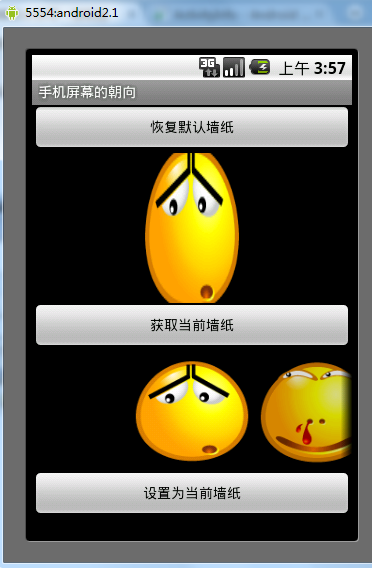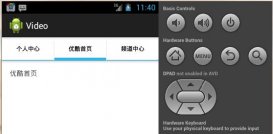本文实例讲述了android实现手机壁纸改变的方法。分享给大家供大家参考。具体如下:
main.xml布局文件:
|
1
2
3
4
5
6
7
8
9
10
11
12
13
14
15
16
17
18
19
20
21
22
23
24
|
<?xml version="1.0" encoding="utf-8"?><linearlayout xmlns:android="http://schemas.android.com/apk/res/android" android:orientation="vertical" android:layout_width="fill_parent" android:layout_height="fill_parent"> <button android:id="@+id/clearwall" android:layout_width="fill_parent" android:layout_height="wrap_content" android:text="恢复默认墙纸" /> <imageview android:id="@+id/currwall" android:layout_width="100px" android:layout_height="150px" android:layout_gravity="center_horizontal" /> <button android:id="@+id/getwall" android:layout_width="fill_parent" android:layout_height="wrap_content" android:text="获取当前墙纸" /> <gallery android:id="@+id/gallery" android:layout_width="fill_parent" android:layout_height="wrap_content" /> <button android:id="@+id/setwall" android:layout_width="fill_parent" android:layout_height="wrap_content" android:text="设置为当前墙纸" /></linearlayout> |
清单文件:
|
1
2
3
4
5
6
7
8
9
10
11
12
13
14
15
16
17
18
|
<?xml version="1.0" encoding="utf-8"?><manifest xmlns:android="http://schemas.android.com/apk/res/android" package="com.ljq.activity" android:versioncode="1" android:versionname="1.0"> <application android:icon="@drawable/icon" android:label="@string/app_name"> <activity android:name=".wallactivity" android:label="@string/app_name"> <intent-filter> <action android:name="android.intent.action.main" /> <category android:name="android.intent.category.launcher" /> </intent-filter> </activity> </application> <uses-sdk android:minsdkversion="7" /> <!-- 设置手机墙纸权限 --> <uses-permission android:name="android.permission.set_wallpaper" /></manifest> |
walladapter自定义适配器:
|
1
2
3
4
5
6
7
8
9
10
11
12
13
14
15
16
17
18
19
20
21
22
23
24
25
26
27
28
29
30
31
32
33
|
package com.ljq.activity;import android.content.context;import android.view.view;import android.view.viewgroup;import android.widget.baseadapter;import android.widget.gallery;import android.widget.imageview;public class walladapter extends baseadapter { private int[] imgids = null; private context context = null; public walladapter(int[] imgids, context context) { super(); this.imgids = imgids; this.context = context; } public int getcount() { return imgids.length; } public object getitem(int position) { //return imgids[position]; return imgids[position%imgids.length];//可循环 } public long getitemid(int position) { return position; } public view getview(int position, view convertview, viewgroup parent) { imageview imageview = new imageview(context); imageview.setbackgroundresource(imgids[position]);// 设置imageview的背景图片 imageview.setscaletype(imageview.scaletype.center_crop); imageview.setlayoutparams(new gallery.layoutparams(120, 120)); return imageview; }} |
wallactivity类:
|
1
2
3
4
5
6
7
8
9
10
11
12
13
14
15
16
17
18
19
20
21
22
23
24
25
26
27
28
29
30
31
32
33
34
35
36
37
38
39
40
41
42
43
44
45
46
47
48
49
50
51
52
53
54
55
56
57
58
59
60
61
62
63
64
65
66
67
68
|
package com.ljq.activity;import java.io.ioexception;import java.io.inputstream;import android.app.activity;import android.os.bundle;import android.view.view;import android.widget.adapterview;import android.widget.button;import android.widget.gallery;import android.widget.imageview;import android.widget.adapterview.onitemselectedlistener;public class wallactivity extends activity { private int[] imgids={r.drawable.w1, r.drawable.w2, r.drawable.w3, r.drawable.w4}; private int selectindex=-1;//被选中的图片在id数组中的索引 private imageview currwall=null; private gallery gallery=null; private button clearwall=null; private button getwall=null; private button setwall=null; @override public void oncreate(bundle savedinstancestate) { super.oncreate(savedinstancestate); setcontentview(r.layout.main); gallery=(gallery)findviewbyid(r.id.gallery); gallery.setadapter(new walladapter(imgids, wallactivity.this)); gallery.setspacing(5); gallery.setonitemselectedlistener(new onitemselectedlistener(){ public void onitemselected(adapterview<?> parent, view view, int position, long id) { selectindex = position;//记录被选中的图片索引 } public void onnothingselected(adapterview<?> parent) { } }); currwall=(imageview)findviewbyid(r.id.currwall); clearwall=(button)findviewbyid(r.id.clearwall); getwall=(button)findviewbyid(r.id.getwall); setwall=(button)findviewbyid(r.id.setwall); clearwall.setonclicklistener(listener); getwall.setonclicklistener(listener); setwall.setonclicklistener(listener); } view.onclicklistener listener=new view.onclicklistener(){ public void onclick(view v) { button btn=(button)v; switch (btn.getid()) { case r.id.clearwall://还原手机壁纸 try { wallactivity.this.clearwallpaper(); } catch (ioexception e) { e.printstacktrace(); } break; case r.id.getwall://设置imageview显示的内容为当前墙纸 currwall.setbackgrounddrawable(getwallpaper()); break; case r.id.setwall://设置墙纸 inputstream in=wallactivity.this.getresources().openrawresource(imgids[selectindex]); try { setwallpaper(in); } catch (ioexception e) { e.printstacktrace(); } break; } } };} |
运行结果:

希望本文所述对大家的android程序设计有所帮助。














